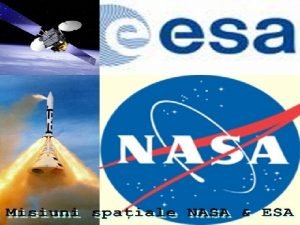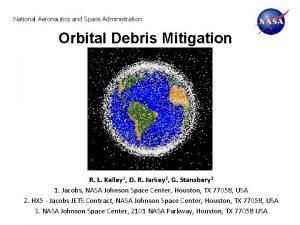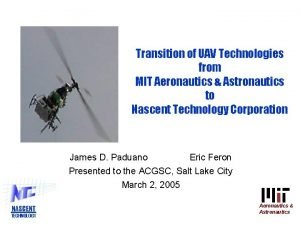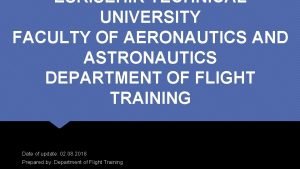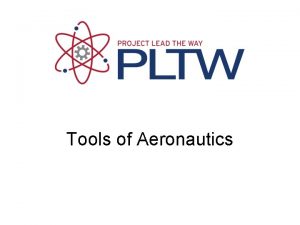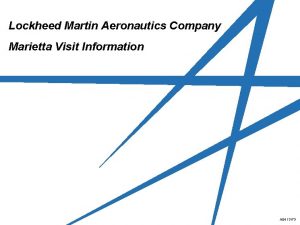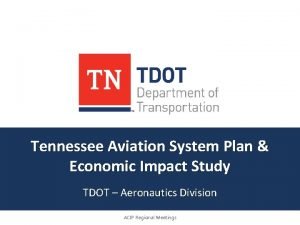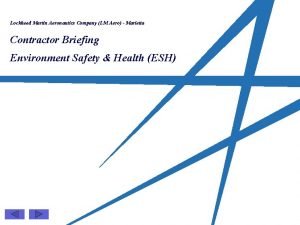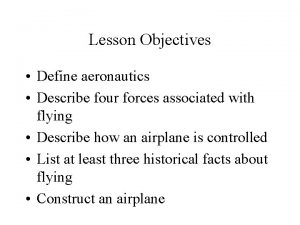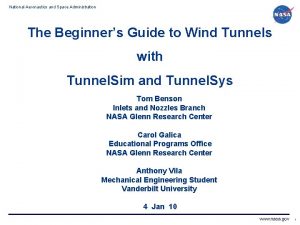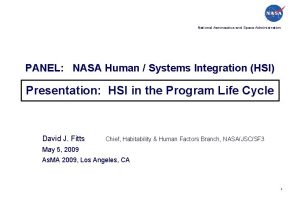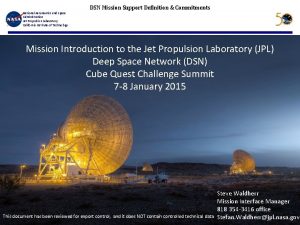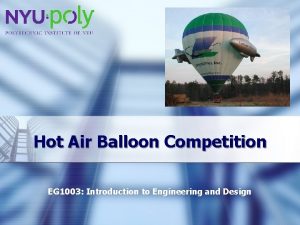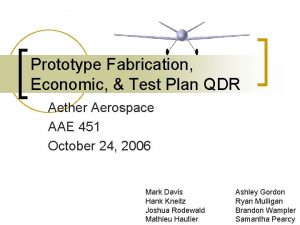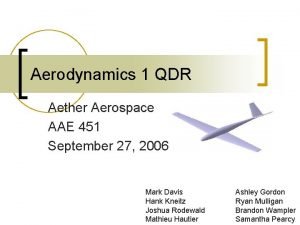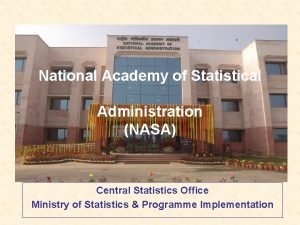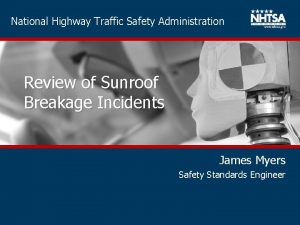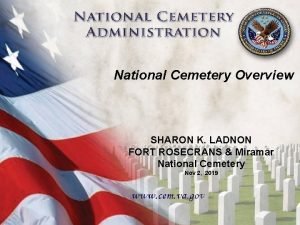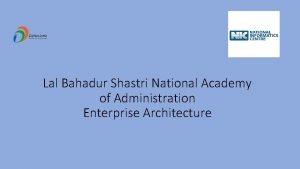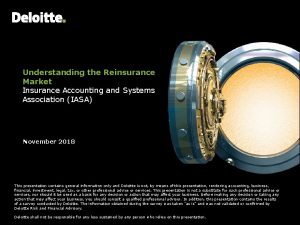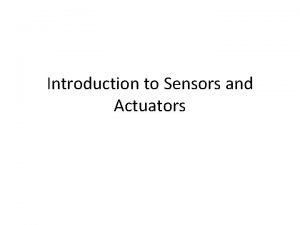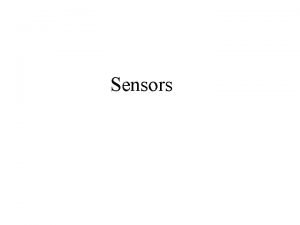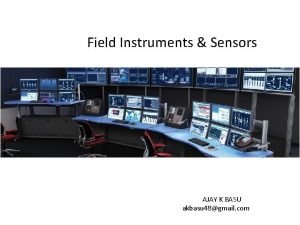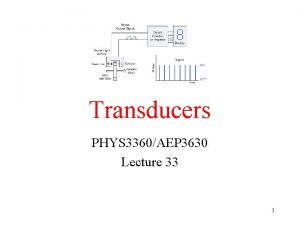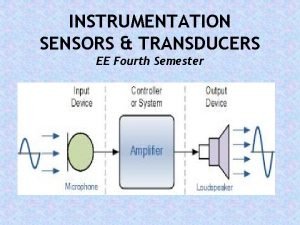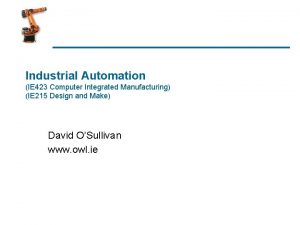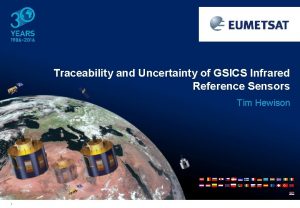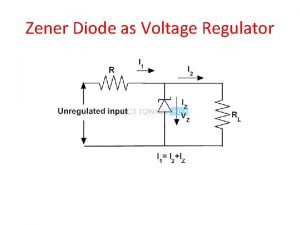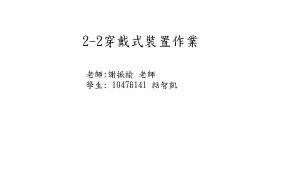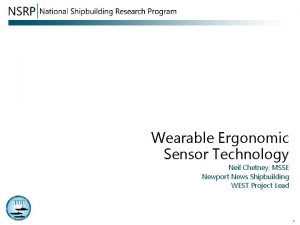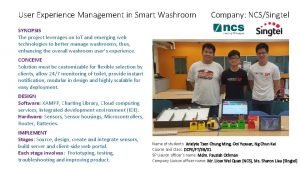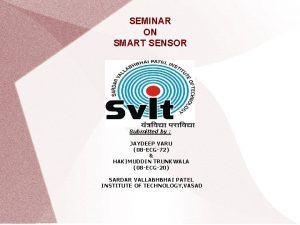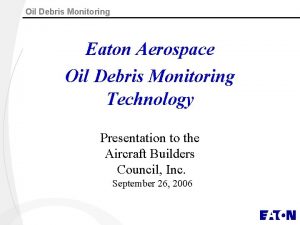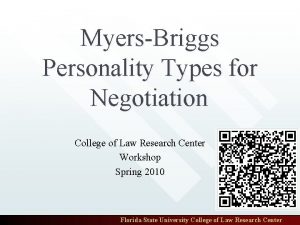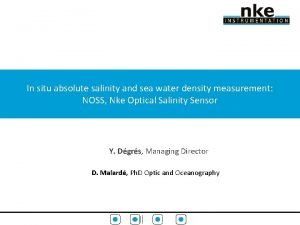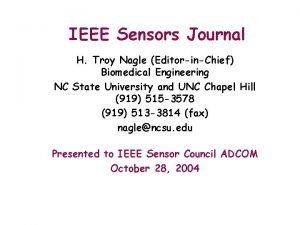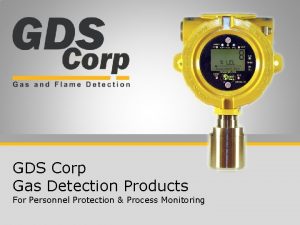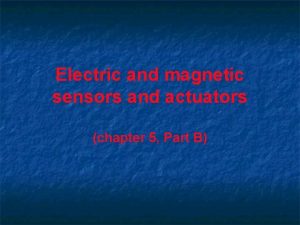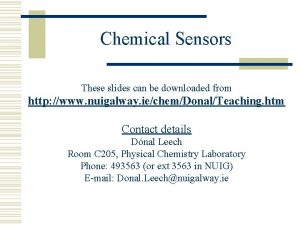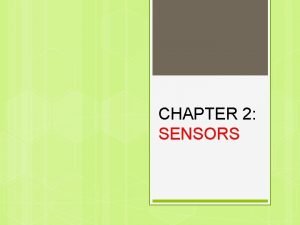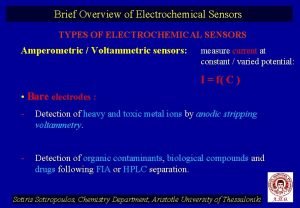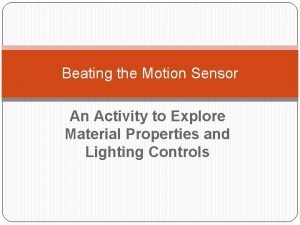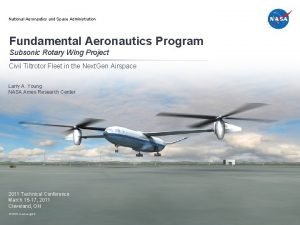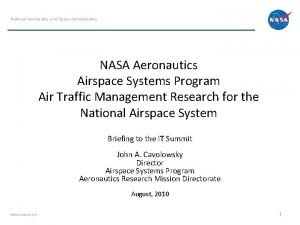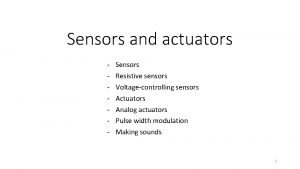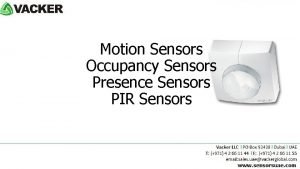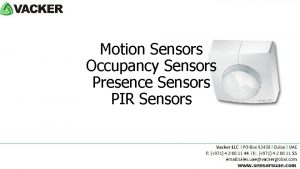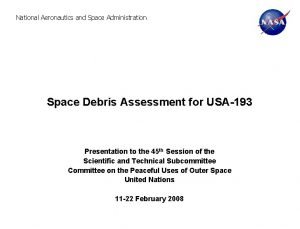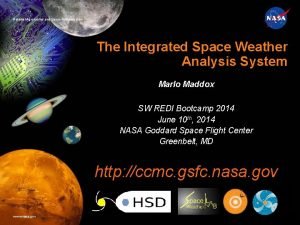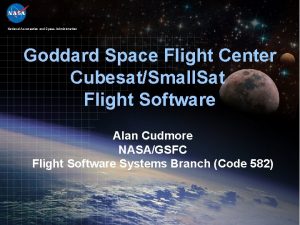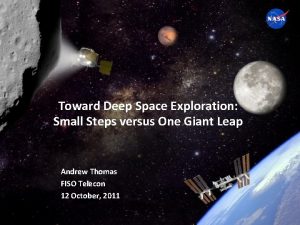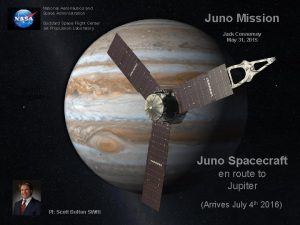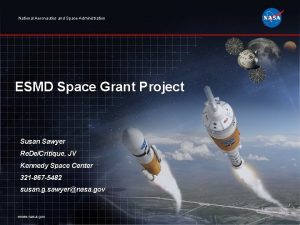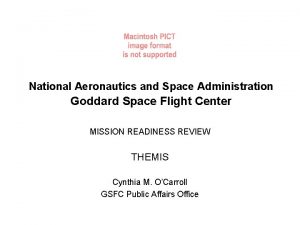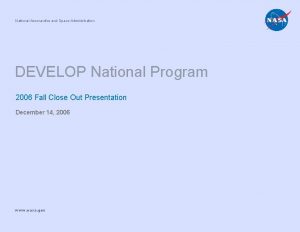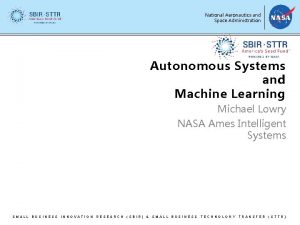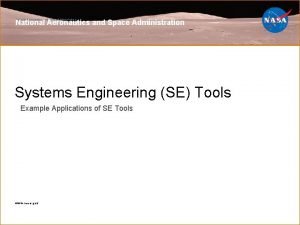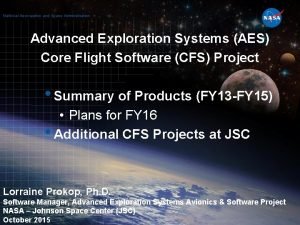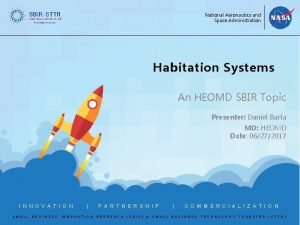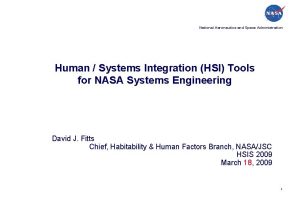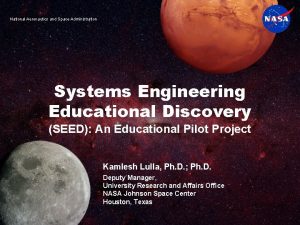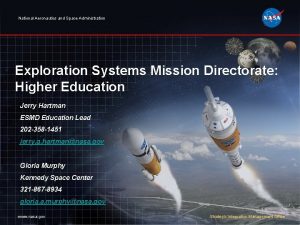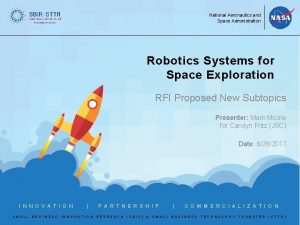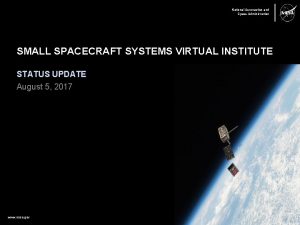National Aeronautics and Space Administration Sensors and Systems












































- Slides: 44

National Aeronautics and Space Administration Sensors and Systems for Spacesuits Advanced Spacesuit Development Portable Life Support Subsystem Pressure Garment Subsystem Presenter: Cinda Chullen MD: HEOMD Date: 6/26/2017 I N N O V A T I O N SMALL BUSINESS | INNOVATION P A R T N E R S H I P RESEARCH (SBIR) & SMALL | C O M M E R C I A L I Z A T I O N BUSINESS TECHNOLOGY TRANSFER (STTR)

Advanced Spacesuit Development • An Advanced Extravehicular Mobility Unit (EMU) is being developed and tested in house at JSC – Multiple programs over the last decade have contributed to the success thus far including the SBIR/STTR program • WHY – The current EMU on International Space Station (ISS) has a limited life span – Future missions being contemplated will need a new spacesuit to meet the technology objectives • Considerable Extravehicular Activity (EVA) technology development has taken place over the last 10 years in preparation for future missions • EVA systems need technology development to prepare for future space missions – Technology developments, challenges, and future gaps have to be tackled by government, industry (including small businesses), academia, and international partners collaboratively • We want better, safer, and more efficient EVA systems • Increased collaboration is necessary to address the challenges and fill the gaps 2

Advanced Spacesuit Development Advanced Extravehicular Mobility Unit (AEMU) Extravehicular Mobility Unit (EMU) 3

Spacesuit Subsystems • Portable Life Support Subsystem (PLSS) • Pressure Garment Subsystem (PGS) 4

Advanced Spacesuit Development Subsystems 5

NASA Advanced Spacesuit Reference Architecture 6

Advancements Over the State of the Art – PLSS – • Rapid Cycle Amine (RCA) swing bed enables real-time on-back regenerable CO 2 and humidity control (eliminates CO 2 removal as an EVA duration limiting consumable, eliminates Lithium Hydroxide (Li. OH) as a mission consumable, eliminates power and time to regenerate Metal Oxide (Met. Ox) post EVA) • Suit Water Membrane Evaporator (SWME) has decreased sensitivity to water quality and increased life as compared to a sublimator (100+ EVA life), • Variable Oxygen Regulator (VOR) enables numerous set points that can include in-suit decompression sickness, eliminating prebreathe, or interfacing with multiple vehicles – Primary Oxygen Regulator (POR) – Secondary Oxygen Regulator (SOR) – PGS • 8 psid operations eliminates the need for prebreathe and provides in suit decompression sickness treatment • Rear entry decreases donning time, pressurized sizing adjustment features – Informatics – • Improved capabilities include displays and information systems to provide crew autonomy • Integrated audio system into the suit to eliminate the communications cap providing improved reliability and crew comfort • Advanced caution and warning system includes sharing telemetry between EVA crew 7 members and automated health checks

Technology Development PORTABLE LIFE SUPPORT SUBSYSTEM (PLSS) 8

Portable Life Support Subsystem Technology Development COMPLETE PLSS 1. 0 (Breadboard) FY 16/17/18 COMPLETE PLSS 2. 0 (Packaged GN 2) PLSS 2. 5 (x. PLSS) (Flight prototype) Purpose: • Schematic validation with models • Component pneumo-hydraulic integration • Packaged lab unit • System level performance • Flight design without paperwork (GN 2/Air only) • Integrated system performance Hardware : • Prototype: RCA, Fan, SWME, POR, SOR • Balance COTS/Instruments • 2 nd gen prototypes: RCA, SWME, POR, SOR • 1 st gen prototypes: remainder • 3 rd gen prototypes; RCA, SWME, POR, SOR • 2 nd gen prototypes: remainder Testing: • 8 simulated EVA transient profiles • 397 hrs of full PLSS operation • 595 hrs of SWME/thermal loop operation • Pre-Installation Acceptance (PIA) test against system spec • 19 psia air human-in-the-loop testing with the Mark III spacesuit (2 hr EVAs) • 25 EVAs, failure simulations, integration tests at vacuum • • • PIA test against system spec 100 unmanned EVAs in vacuum Unmanned thermal vacuum testing Pressurized launch vibe testing EMI Testing Static Magnetics Testing 9

Core PLSS Component Technologies • Rapid Cycle Amine (RCA) swingbed provides CO 2 and humidity removal via a two bed chemical sorbent canister – – • Advantages: Real-time regenerative – CO 2 removal system will not limit EVA duration and reduces consumables; Eliminates most failure modes that introduce water into the helmet and space suit RCA 1. 0 and 2. 0 were tested at a component level and within the PLSS 1. 0 and PLSS 2. 0 system including manufacturing, assembly, functional verifications, and air rig performance testing Variable Oxygen Regulator provides dual stage pressure regulation for oxygen and pressure control for space suits – – RCA 3. 0 Advantages: Continuously adjustable pressure settings (~4000 set points) to control suit pressure between 0 and 8. 4 psid with robust design, tolerant of contamination & combustion events VOR 1. 0 and 2. 0 were tested at a component level and within the PLSS 1. 0 and PLSS 2. 0 systems, including oxygen and contaminant compatibility testing at WSTF as well as thermal, vibration and orientation testing VOR 2. 0 • Suit Water Membrane Evaporator (SWME) provides heat rejection and water degassing via hollow fiber membranes – – • Gen 2 and Gen 3 SWME included improvements such as reduced size, new fabrication methods, and more flight-like backpressure valve and were tested at the component level and within the PLSS 1. 0 and PLSS 2. 0 systems Gen 4 SWME is currently under development for use in PLSS 2. 5 Highest fidelity components being incorporated into system Live Loads Testing this summer SWME Gen 3 10

PLSS Packaging Battery Modules Trace Contaminan t Control Feedwater Supply For NASA Internal Use Only 11

Technology Needs - PLSS These are technology gaps from the current state of the art -- areas that would lend themselves to SBIR/STTR and STMD development projects. 1. Continuous CO 2/Relative Humidity removal capability that can operate within the vacuum and Martian atmospheres a. Update/supersede SA 9 T (TEPAN)1 state of the art i. Improvements in sorbent CO 2/H 2 O uptake 2 ii. Independence of CO 2 adsorption on H 2 O concentration iii. Alternative processes such as temperature swing adsorption, selective permeable membranes, etc. b. Augment SA 9 T (TEPAN) operation using thermal swing adsorption approach c. Augment SA 9 T (TEPAN) operation using boost compressor to enable pressure swing operation in the Martian atmosphere 12

Technology Needs - PLSS 2. Continuous trace contaminant removal capability a. Activated charcoal is the state of the art and provides a logistics impact to all exploration reference missions 3 b. Remove ammonia (NH 3), carbon monoxide (CO), formaldehyde (CH 2 O), methanethiol (also known as methyl mercaptan) (CH 3 SH), etc. c. The minimum objective would be to remove all of the significant compounds that threaten to exceed the 7 -day SMAC 4 during an EVA with the optimal objective to enable removal of less significant compounds d. Ideally, this is either passive membranes or actively switched regenerating beds that can be paired with the CO 2/RH removal approach 13

Technology Needs - PLSS 3. Small, oxygen compatible gas flow meter for suit operations a. Current state of the art is a flapper valve attached to a micro-switch used on ISS EMU b. This is limited to a single set-point and is not capable of providing any suit health trending to enable graceful degradation and maintenance of fan performance or ventilation loop obstructions c. The system is highly constrained on volume, power, mass, g-loading, pressure drop and further limited by compatibility with 100% O 2 at pressures up to 25 psia i. The pressure drop over-constrains traditional flow-DP sensing methods such as orifice plates, V-cones, etc as the DP sensors themselves which have demonstrated issues such as orientation sensitivity/vibration sensitivity when measuring these low ranges (~0. 7 in-H 2 O at 4. 3 psia, 4. 5 acfm) ii. In a similar fashion, commercial off-the-shelf (COTS) thermal mass flow solutions are often limited by the O 2 compatibility constraints as many nonmetallics used have oxygen indexes far less than 100; potential human generated contamination and kindling chain effects also impose burdens on the designs. 14

Technology Needs - PLSS 4. Small hermetic micro switches a. Current state of the art is 3 -5 x larger than needed 5. Rad-hard, isolated DC/DC converters with an efficiency of >80% a. State of the art is ~70% for 28 V to 5 V b. Example is the MS Kennedy P/N BBF 2805 S c. Developing more efficient rad-hard by design DC/DC converters that save >10% on regulated loads would reduce the waste heat rejected by the evaporator by > 5 W and the battery size by 40 -50 Wh (size equivalent to nominal laptop battery). 6. Multi-gas monitoring a. We cannot envision the premise now because the state of the art is too large and power hungry to enable it, but the suit could benefit from measuring: i. Oxygen (O 2), carbon dioxide (CO 2), water (H 2 O), ammonia (NH 3), carbon monoxide (CO), formaldehyde (CH 2 O), methanethiol (also known as methyl mercaptan) (CH 3 SH), etc. b. The measuring of the trace contaminants becomes more necessary if we manage to achieve a pressure or temperature swing adsorption continuous removal approach for trace contaminants as it would remove the traditional activated charcoal cartridge from the list of logistics items but would require some level of validation that the function was operating beyond the human nose. 15

Technology Needs - PLSS 7. Dust-tolerant Quick Disconnects (fluids and electrical) a. Need low mating force, small, dust tolerant quick disconnects that improve on the current b. state of the art, the EMU Service and Cooling Umbilical (SCU) Fluids include (2) 3750 psia oxygen ports, (3) 35 psi water, (1) 80 pin electrical connection with a mandate that the connections be capable of mating/demating under all pressure combinations 8. Power a. Safe, high-energy density power sources that are rechargeable post-EVA b. Current state of the art is Li-Ion batteries with cell level energy densities of 200 Wh/kg but packaged energy densities of ~130 Wh/kg after addressing mitigation for thermal runaway 9. Heat rejection compatible with vacuum and Martian environment (depending on a future system analysis, this may not be broken) a. The current state of the art is the Spacesuit Water Membrane Evaporator (SWME) with b. c. d. degraded performance under Martian conditions Lithium chloride (Li. Cl) radiators that capture the H 2 O vapor from the SWME provide a potential solution A boost compressor on the SWME vapor outlet could potentially yield improved cooling A radiator that uses the reduced capacity SWME as a topping cooler could potentially work (this was examined during the schematic studies, 2006 -2007) 16

Technology Needs - PLSS 10. Heat Transport Improvements a. Improve the Liquid Cooling and Ventilation Garment (LCVG) state of the art b. Improve the UA such that warmer water can be used to sink the waste heat from the human and hence reduce the evaporator size c. Drastically alter the human to cooling loop interfaces such as a fluid filled suit with pumped directly cooled water d. Alter the Thermal Micrometeoroid Garment (TMG) such that the emissivity/absorptivity can be dynamically altered to improve thermal regulation 11. Human-Machine Interface Improvements a. Current state of the art includes mechanical switches and a 16 x 2 Liquid Crystal Display (LCD) b. Low power, wide thermal range, rad tolerant high definition graphics displays that can be integrated with the suit softgoods or hard goods c. Heads up displays 12. Suitport vehicle interfacing a. Airlocks are still the state of the art. If we are to ever use suitport beyond conceptual planning, investment needs to be made to assess and overcome issues with the concept 17

Technology development PRESSURE GARMENT SYSTEM (PGS) 18

Pressure Garment Technology Development 2010 Cx. P 2016 2012 AES/GCD • Exploration mission trade study support via timeline analysis and end-to-end analog testing with pressurized suits, robotic assistants, and mid -fidelity vehicles/habitats • Exploration pressure garment requirements development • Suit fit and strength analysis • Extensive multi-suit mobility studies • Suited joint torque • Dust/dirt protection and mitigation • Suit mass and center of gravity Z-2 ATP • Mobility demonstrator • First prototype compatible with delta pressure suitport don/doff evaluations • Optimized for larger crew population Z -2 2016 Z -1 2011 ETDD/ETDP REI 2006 WEI 1998 MK III 1992 2005 • Highest fidelity planetary prototype since Apollo • Rated for 100% oxygen environments • Certified for testing in the NBL • Optimized for smaller crew population

Z-2 Design Features Hybrid Composite Hatch (Carbon/SGlass/AL) Integrated Comm. Systems Ti Waist Bearing w/1. 75” Integral Sizing Ring Composite Brief Removable SIP (not shown) 13 x 11 Elliptical Hemispherical Helmet 2 Bearing Rolling Convolute Shoulder RC Waist Joint EMU Style Acme Thread FAR 2 Bearing Toroidal Convolute Soft Hip Ankle Bearing Gen 2 Adjustable Walking Boot Composite Hard Upper Torso (HUT) (Carbon/S-Glass) (1” Vernier Sizing) For NASA Internal Use Only 20

High Performance EVA Glove (HPEG) • Gas Pressurized EVA Gloves – Link-net bladder/restraint test article • Completed fabrication • Received one pair in Jun 2016 – Gas pressurized glove prototypes • Completed fabrication • Held Pre-Test Review Link-Net Bladder/Restraint and Cover Layer Gas Pressurized Glove Prototypes • Completed verification testing • Received two pairs in Aug 2016 – Testing of prototypes Fall 2016 • Mechanical Counter Pressure Gloves – Held Pre-Test Review – Completed manned glovebox Glovebox Testing of Mechanical Counter Pressure Prototypes

High Performance EVA Glove (HPEG) • Robotically Assisted EVA Gloves – Completed hardware upgrades to the 2 nd Space Suit Robo. Glove (SSRG) prototype – New system includes sensors that determine finger position to enable more precise control and “power steering” to ease the effort required to execute grasps – Evaluations Sep 2016 New enhancements on SSRG prototype 2 • Sensor Suite – Completed successful NBL test on July 11, 2016 • Over 4 hours of data collected • Approximately 30 sensors measuring fingernail strain, force, temperature and humidity • Test report Fall of 2016 Sensor Suite NBL Test

Technology Needs - PGS Dust Tolerant Mechanisms • Space suits for planetary exploration will be required to operate nominally in a coarse dirt and fine dust environment for up to 600 hrs with minimal maintenance required • Nominal operation is considered less than 10% increase in running torque for bearings, less than 10% increase in actuation torque for disconnects, and less than 2 sccm increase in leakage • Key mechanisms in space suits include: – Quick disconnects for oxygen, water, and power/data lines; gas exhaust ports, relief and purge valves – Bearings in the pressure garment arms, legs, and waist – Component hard disconnects at the pressure garment wrist, arm, waist thigh, and ankle; and hinges at the pressure garment rear hatch • Desired Technology Capabilities: 23

Technology Needs - PGS Textiles for High Abrasion Environments • NASA needs suit material(s) and systems of layers of materials that are capable of long duration exposure to dust and abrasive activities that are also flexible so as not to compromise mobility (walking, kneeling, etc. ) • Desired Technology Capabilities: – Self-healing textiles – Damage sensing textiles – Manufacturing techniques to minimize dust migration between textile layers – Textiles or coatings with active dust repellant features 24

Technology Needs - PGS Thermal Insulation for Non-Vacuum Environments • Current space suit insulation technologies rely heavily on the vacuum of the low-earth orbit environment to minimize heat transfer by separation of layers in the space suit material lay-up • However, various exploration destinations, and specifically Mars, exhibit low pressure atmosphere which allows convection to occur • Desired Technology Capabilities: – Lightweight, flexible, durable, and thin to minimize interference with mobility features of suits (Note: If one or more of the above characteristics is an issue, but could be resolved 25

Technology Needs – PGS Mass Reduction Strategies • Launch mass from Earth’s surface has always been a challenge but introduction of gravity environment for EVA will create greater need for reduced on-back mass. • Gravity environments will increase the need for finer alignment of EVA suit system CG to optimize mobility and efficiency. • Desired Technology Capabilities: – Composite lay-ups that meet load requirements (pressure and impact) with minimal mass – High reliability methods for fabricating complex composite geometries – In-situ printing of replacement suit 26

Technology Needs - PGS • Other focus areas for technology development: – Visors – Better shading for UV – Environmental Protection Garment • Quick change out, micrometeorite tolerant, and dust tolerant – Biomed Sensors • Required: Heart Rate, EKG, & O 2 Tolerant • Desired: Respiration & non-contact – Bearings • Lightweight bearings (possibly nonmetallic to mitigate shock paths) 27

Technology Needs – PGS Related Dust Mitigation Strategy for Remote Habitats • Exclusion of dust from habitable environments is a system level challenge • Space suited crewmembers will bring some amount of dust into the habitat following each EVA. In reduced gravity environments fine dust does not quickly settle out of the habitat atmosphere. • Desired Technology Capabilities: – System to remove/repel dust from space suits – System to remove and collect dust from the habitat atmosphere – System to remove and collect dust from 28

SBIR INFUSION SUCCESS STORIES 29

SBIR Infusion Success Story Vista Photonics Multi-Gas Monitor

Vista Photonics Multi-Gas Monitor • NASA wanted to improve its ability to monitor the ISS habitable environment • SBIR Phase I awarded to Vista Photonics, Inc. – Purpose: Develop a single, portable gas analyzer that can detect multiple gases (i. e. , oxygen, carbon dioxide, water vapor, and ammonia) – Multi-Gas Monitor (MGM) is the first laser sensor to continuously measure these gases on a spacecraft – Monitoring these gases is crucial for ensuring crewmembers’ health aboard the ISS – Prior to the MGM, three separate devices were used to monitor these gases • • • November 2013: MGM launched on Soyuz 37 February 2014: MGM activated Device has operated well past its initial 6 -month technology demonstration period NASA is now expanding the technology's gas-monitoring capabilities for use in Orion January 14, 2015: – Astronauts and cosmonauts onboard the ISS evacuated to the Russian side of the outpost after an ammonia leak was detected – MGM, which detects ammonia, helped determine that the ammonia leak aboard the ISS was a false alarm 31

PLSS CO 2 Sensor h P a t Vis . c n I , s c i n o ot Compact Optical Carbon Dioxide Monitor for EVA Phase II SBIR Compact Optical Carbon 2009 Dioxide Monitor for EVA • Develop rugged, Phase I SBIR compact, low-power optical sensor 2008 prototypes • Concept Development • CO 2 at EVA-relevant • Low power infrared concentrations optical source • Wavelength • High-sensitivity of modulation established optical spectroscopy (WMS) absorption detection approach techniques In Situ Water Isotope Analyzer for Moon Exploration SBIR Phase II, IIe, III 2010 -2013 ● Combined ultrasensitive WMS with emerging long wavelength infrared laser diodes • Improved CO 2, H 2 O, and O 2 sensing High-Performance Infrared Laser Sensor Technology & ISS EMU Sensor Candidate SBIR CRP, Phase III 2015 -2017 • First Prototype – PLSS Gas Sensor delivered with upgraded line locking from MGM • Delivered the In-Flight Contingency Monitor (IFCM) for Orion 32

Role of Small Businesses in EVA Topic Area • Infusion Success! A small business solution via the SBIR/STTR process is now baselined in the PLSS. Therefore, a significant contributor to the advanced spacesuit development. • We want more successes!! • For the EVA Topic Area, the list of technology needs presented herein is the most recent exhaustive listing published for the EVA Topic Area at one time. • Most of the technology needs listed herein are technology gaps from the current state of the art -- areas that would lend themselves to SBIR/STTR and STMD development projects. • Small businesses are encourage to review the technology needs presented within and feel free to contact any of the POCs to find out more. – If you have a good idea or a potential solution to any of the technology needs, we want to hear about it. • It is okay for small businesses to not have flight experience. NASA can provide you guidance should you have an idea or a potential solution. 33

SBIR Phase I – Current Awards • SBIRs – Phase I (SBIR 2017 -I, 6/2017) 1. Adv Materials Innovations, San Diego, CA • “Sensor to Measure Space Suit Interactions with the Human Body” 2. Composites Automation, LLC, Newark, DE • “Impact Resistant Composite Structures for Space Suit Applications” 3. Creare, LLC, Hanover NH • “Compact, High-Accuracy Oxygen Flow Meter” 4. Maher & Associates, LLC, Baltimore, MD • “Damage Tolerant Composite Systems for Spacesuits” 5. Somatis Sensor Solutions, Las Angeles, CA • “Flexible Polymer Sensor for Space Suits” 6. STF Technologies, LLC, Newark, DE • “Impact-Resistant, Damage-Tolerant Composites with STF Energy Absorbing Layers” 34

SBIR Phase II – Current Awards • SBIRs – Phase II 1. Intelligent Optical Systems, Inc. (SBIR 2014 -II, 5/2015) • “Non-Intrusive, Distributed Gas Sensing Technology for Advanced Spacesuits” 2. NEI Corporation, Piscataway, NJ (SBIR 2014 -II, 7/2015) • “Shock Hazard Prevention Through Self-Healing Insulative Coating on SSA Metallic Bearings” 3. Air-Lock, Inc. , Milford, CT (SBIR 2015 -II, 4/2016) • “Contact Stress Design Parameters for Titanium Bearings” 4. Innoflight, Inc. , San Diego, CA (SBIR 2015 -II, 5/2016) • “Compact Wireless EVA Communication System” 5. Nanosonic, Inc. , Pembroke, VA (SBIR 2015 -II, 6/2016) • “Multifunctional, Self-Healing Hybridsil Materials for EVA Space Suit Pressure Garment Systems” 6. Serionix, Champaign, IL (SBIR 2016 -II, 4/2017) • “Fiber-Based Adsorbents Tailored for PLSS Ammonia and Formaldehyde Removal” 7. Precision Combustion, Inc. , North Haven, CT (SBIR 2016 -II, 4/2017) • “Novel, Vacuum-Regenerable Trace Contaminant Control System for Advanced Spacesuit Applications” 35

STTR – Current Awards • • • STTRs – Phase I (STTR 2017 -I, 6/2017) 1. Creare, LLC, Hanover NH • “Volume Sensor for Flexible Fluid Reservoirs in Microgravity” • Dartmouth College, Hanover NH STTRs – Phase I (STTR 2016 -I, 6/2016) 1. LUNA, Inc. , Roanoke, VA • “Environmentally Protective Fabrics for Spacesuits” • North Carolina State University, Raleigh, NC 2. Seacoast Science, Inc. , Carlsbad, CA • “Low Mass/Power Sensor Suite for Spacesuits” • Case Western Reserve University, Cleveland, OH 3. STF Technologies, LLC, Newark, DE • “Shear Thickening Fluid Enhanced Textiles for Durable, Puncture- and Cut. Resistant Environmental Protection Garments” • University of Delaware, Newark, DE STTRs – Phase II (STTR 2015 -II, 9/2016) 1. Intelligent Optical Systems, Inc. , Torrance, CA • “Advanced Gas Sensing Technology for Space Suits” • University of North Texas, Denton, TX 2. N 5 Sensors, Inc. , Germantown, MD • “Nanoengineering Hybrid Gas Sensors for Spacesuit Monitoring” • George Mason University, Fairfax, VA 36

HOW TO GET STARTED 37

How to Get Started Tips for success in the EVA Topic Area • Be aware of technology needs before the solicitations are released • Reach out to the EVA Topic Manager, Subtopic Managers, and Subsystem Team Leads to see what is going on and what may be upcoming. – A comment we received from one vendor only days before the black-out period, “If I would have known in advance it was so easy to contact you, I would have done it weeks ago”. – We have provided tours of our labs to help understand the complexity of the suit development. This is to also share what in house work is currently being done and what development is still needed. Tours are not provided during black-out period. • Talk to an NASA EVA discipline expert about good ideas for the suit – They can provide guidance & insight – Major component leads are good to contact as well • Be cautious during Phase I Solicitations - Once proposal period starts, a black-out period begins – discussions are no longer 38

How to Get Started Tips for success in the EVA Topic Area • Attend workshops and conferences – International Conference on Environmental Systems (ICES) https: //www. ices. space/ – SBIR/STTR Industry Day • Visit the SBIR/STTR Website regularly http: //sbir. nasa. gov • Research the Technology Roadmaps for EVA technology gaps – Although these Roadmaps were developed some time ago, they are still relevant for EVA technology – http: //www. nasa. gov/offices/oct/home/roadmaps/index. html • Subscribe to the SBIR/STTR News • Be attentive to recommendations from Investigation Reports 39

How to Get Started Tips for success in the EVA Topic Area • BE AWARE!!! • Schedules and solicitation cycles vary • If you are lucky enough to win a SBIR/STTR contract – Deliver all products on time – Communicate, Communicate with your Contracting Officer Representative – The most successful vendors communicate regularly their successes and set backs – Stay on schedule or get ahead! – We love hardware, testing, and lots of data in Phase I’s and Phase II’s. • READ, READ your contract – There are deadlines for Phase II-Extended, Phase II-Enhancement, and Phase IIExpanded – Several of our vendors have just missed their windows of opportunity for Phase II opportunities because they did not read their contracts and the criteria 40

Resources Websites • • NASA SBIR/STTR website http: //sbir. nasa. gov • ICES proceedings are located at https: //www. ices. space/conferenceproceedings. html • Space Technology Roadmaps http: //www. nasa. gov/offices/oct/home/roadmaps/index. html • Spacesuit Knowledge Capture (NESC Academy Online) International Conference on Environmental Systems (ICES) https: //www. ices. space/ http: //nescacademy. nasa. gov/category/5/sub/27 References 1 Birbara, P. J. , Filburn, T. P. , Michels, H. H. , Nalette, T. A. , Hamilton Sundstrand Corporation, Windsor Locks, CT, U. S. Patent for a “Sorbent System and Method for Absorbing Carbon Dioxide (CO 2) from the Atmosphere of a Closed Habitable Environment, ” U. S. Patent Number 6, 364, 938 B 1, April 2, 2002. 2 Chullen, C. , Campbell, C. , Papale, W. , Murray, S. , Wichowski, R. , Conger, B. , and Mc. Millin, S. , “Design and Development Comparison of Rapid Cycle Amine 1. 0, 2. 0, and 3. 0”, 46 th International Conference on Environmental Systems, ICES-2016 -073, Vienna, Austria, July 10 -14, 2016. 3 Paul, H. , Jennings, M. , and Waguespack, G. , “Requirements and Sizing Investigation for Constellation Space Suit Portable Life Support System Trace Contaminant Control”, 40 th International Conference on 41

Points of Contact • Kathryn Packard JSC Technology Infusion Manager kathryn. b. packard@nasa. gov • Cinda Chullen EVA Topic Manager cinda. chullen-1@nasa. gov • Colin Campbell Portable Life Support Subsystem (PLSS) Team Lead colin. campbell-1@nasa. gov • Richard Rhodes Pressure Garment Subsystem (PGS) Team Lead (Acting) richard. a. rhodes@nasa. gov 42

QUESTIONS ? 43

The End THANK YOU FOR YOUR PARTICIPATION! 44
 National aeronautics and space administration
National aeronautics and space administration Space debris
Space debris Mit aeronautics and astronautics
Mit aeronautics and astronautics Pioneer astronautics internship
Pioneer astronautics internship What was the first tool of aeronautics to be developed?
What was the first tool of aeronautics to be developed? Lockheed martin facilities map
Lockheed martin facilities map Tdot aeronautics
Tdot aeronautics Lm aeronautics
Lm aeronautics Define aeronautics
Define aeronautics Beginner's guide to aeronautics
Beginner's guide to aeronautics Aeronautics
Aeronautics Aeronautics definition
Aeronautics definition Part of hot air balloon
Part of hot air balloon Aether aeronautics
Aether aeronautics Aether aeronautics
Aether aeronautics National academy for public administration
National academy for public administration National academy of statistical administration
National academy of statistical administration National highway safety administration reviews
National highway safety administration reviews Miramar national cemetery grave locator
Miramar national cemetery grave locator Lal bahadur shastri national academy of administration
Lal bahadur shastri national academy of administration Reinsurance administration systems
Reinsurance administration systems Sensors and actuators lecture notes
Sensors and actuators lecture notes Introduction to sensors and actuators
Introduction to sensors and actuators Limitations of lvdt
Limitations of lvdt Ajay sensors and instruments
Ajay sensors and instruments Transducers and sensors
Transducers and sensors Transducers and sensors
Transducers and sensors Fixed automation diagram
Fixed automation diagram Sensors and traceability
Sensors and traceability Static characteristics of sensors
Static characteristics of sensors Wearable inertial sensors
Wearable inertial sensors Wearable ergonomic sensors
Wearable ergonomic sensors Smart washroom
Smart washroom Conclusion of smart sensors
Conclusion of smart sensors Monitor oil debris
Monitor oil debris Sensors vs intuitives
Sensors vs intuitives Peas in ai
Peas in ai Density of sea water
Density of sea water Ieee sensors journal impact factor
Ieee sensors journal impact factor Gds sensors
Gds sensors Kmz10b
Kmz10b Chemical sensors ppt
Chemical sensors ppt Sensor definition
Sensor definition Types of electrochemical sensors
Types of electrochemical sensors How to beat motion sensors
How to beat motion sensors
